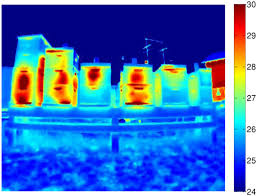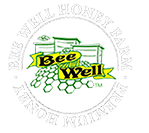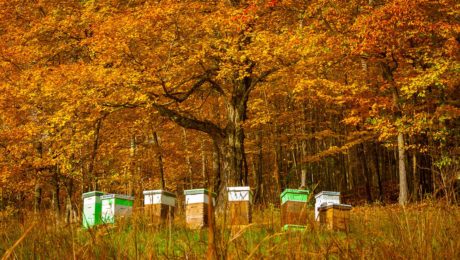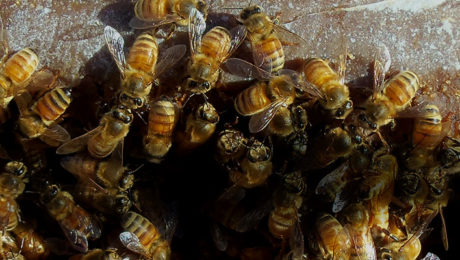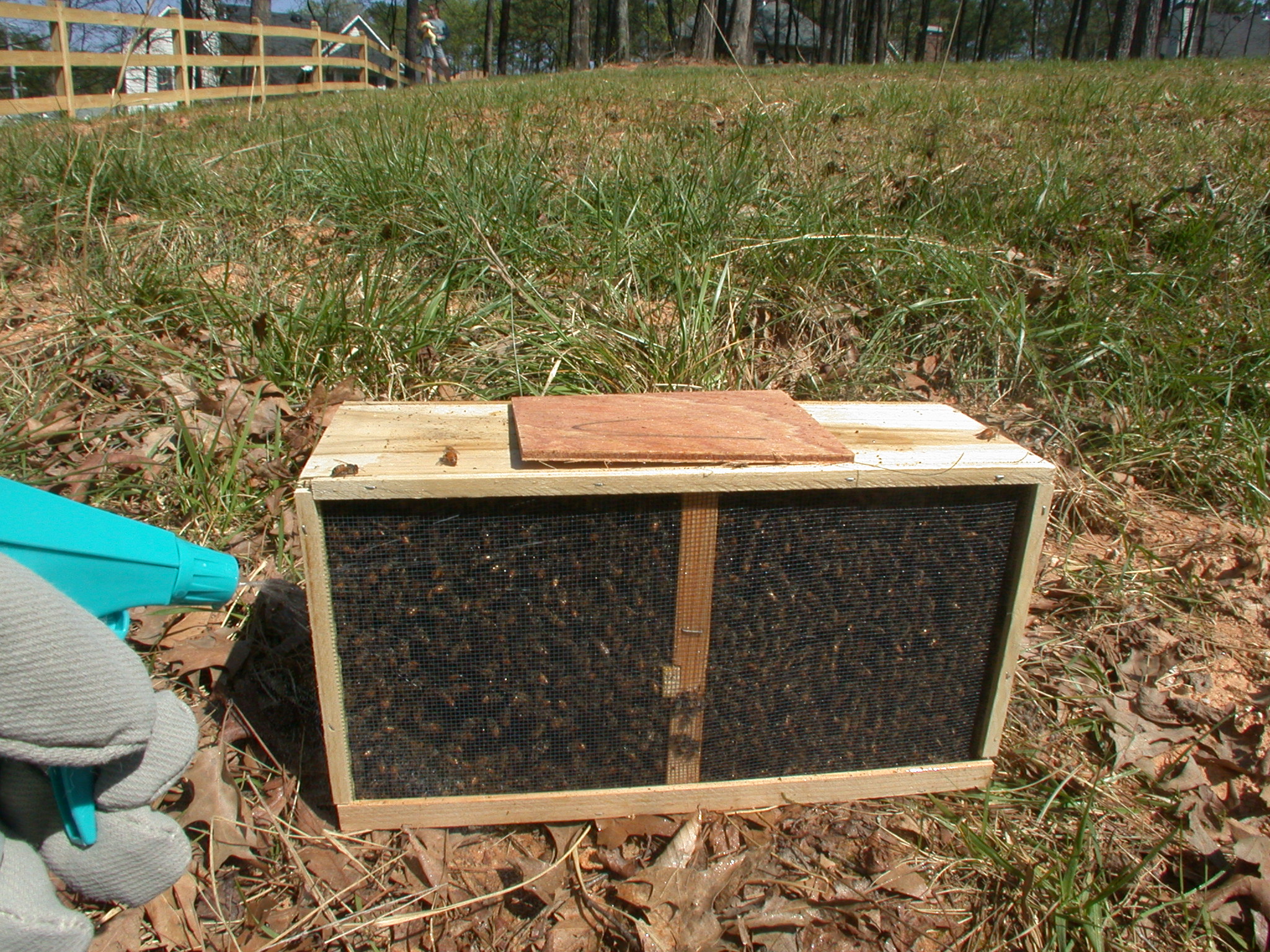Source: Bayer Magazine
Beekeeper Ernst Caspari has 20 colonies of bees that collect honey for him, and he needs to protect his bees against their greatest enemy, the Varroa mite. This parasite, measuring one to two millimetres in length, is a major cause of bee losses during the winter.
The Varroa mite first appeared in Germany in 1978. Caspari still remembers the Varroa-free time before that: “Bee-keeping was simpler. Previously, you could expect losses of up to ten per cent during the winter. A queen might die, or a shrew might get into the beehive.” Now, however, individual beekeepers may lose 30 per cent or more of their bee populations throughout a year. “That is why beekeepers have to take action, otherwise their colonies will not survive for long,” says the 86-year-old from Leverkusen.
The mite finds its way into the bee brood shortly before the brood cells are capped, and reproduces there. The progeny of the mite and the mite itself feed on the bee larvae/pupae. After the young honeybees, which are already damaged, have hatched, the parasite and its progeny also emerge into the open. “The damaged bees,” explains Peter Trodtfeld, bee health expert in the Bayer Bee Care Center and also a beekeeper himself, “are weakened and susceptible to viral infections, such as the deformed wing virus, for example. The bees then hatch with mutilated wings and have a reduced lifespan.”
The Varroa mite is less noticeable in spring when the colony strength is increasing. “But when the number of brood cells or bees decreases in late summer and the mites are reproducing unhindered, the colony is in danger,” explains Trodtfeld. “So the Varroa population has to be reduced towards the end of the summer so that a possible infestation in autumn and winter may be kept as low as possible.”
Since its first appearance of the mite in Germany, Bayer has also been searching for a suitable antidote to protect the honeybee. As a chemical engineer and member of the Leverkusen Beekeepers’ Association, Caspari has followed all the developments from the first study onwards: “In the past, the bees were still being treated with a fumigant – a dreadful stuff that stank and polluted the honeycombs. Bayer’s product containing the active substance coumaphos, on the other hand, was a blessing for us beekeepers when it came onto the market.”
Caspari treats his bees with it every year in winter. “I trickle it over the bees in the bee space, and then when the mites suck the bee blood (haemolymph), they die,” is how he explains its action.
Another chemical varroacide is available that the Leverkusen resident has also used for the control of the Varroa. “These are plastic strips with the active substance flumethrin. You hang them in the beehive, the bees crawl over them and spread the active substance around, which then attacks the parasites’ nervous system,” explains Caspari. Organic acids and other synthetic varroacides are also used in the fight against the Varroa.
Another product containing the active substance flumethrin is being developed by Bayer. With this, the active substance is used in strips with holes in them. These are placed at the entrance to the beehive so that the bees come into contact with the active substance as they enter and leave the hive, where they spread it around.
Ernst Caspari is only too well aware after his many years’ experience that one single product is not sufficient to counteract the Varroa mite. The parasite is constantly developing resistance. “That means that products containing different active substances have to be alternated with one another,” explains Caspari. “All these products are only used after the honey harvest in order to avoid product residues in the honey.”
He does not know exactly how badly his 20 colonies are affected by the Varroa mite. Only after appropriate treatment he can see if many dead mites are lying on the bottom of the hive. But of one thing he is well aware: without the beekeeper’s help, the bee colonies would die within one to three years.
What is the best way to get started as a beekeeper? The first step in your journey may be to choose a source of bees! When buying bees, you will be faced with the decision of purchasing package bees vs nucs. Both choices have advantages and disadvantages.
Package Bees
Thousands of packages of honeybees are sold each year. The most popular size is a 3# (weight) package of bees with a young mated queen. They are transported inside a small wire/wooden box with a can of sugar syrup to feed them on their journey.
Package Bees are the most economical and readily available source of bees. Generally available early in the Spring season, package bees are often preferred for beekeepers who want to get started early in the season.
Nucs
Nucs (also know as nucleus colonies) are small starter bee colonies. A nuc usually consists of 5 frames of bees (including drawn comb, honey and brood) and a mated queen. Not all nucs are created equal and when purchasing you should be clear on the size of the colony (# of frames) you are purchasing.
Which is better – packages vs nucs ?
Which is better for the new beekeeper? Packages vs nucs? Unfortunately, there is no clear answer to this question and the best answer will depend on the genetics of the bees involved, the climate/geographic location and the management style of the beekeeper.
Packages vs Nuc (the nitty-gritty)
Package Bees are more economical, less prone to spread pests or diseases (because no honeycomb is involved), and are more readily available. They are slower to build up a working population and have to go through the queen acceptance procedure.
Nucs – Nuc colonies are more expensive than packages of bees. They include a drawn honeycomb, some brood, and bees to cover the frames. Their mated queen will already be laying and accepted. This gives them a jump start initially over package bees. However, the presence of a drawn comb also brings with it the opportunity for pests and disease.
Both package bees and nucs are a great way to get started in beekeeping. Bee Well Honey Farm has been providing bees to area beekeepers for more than 20 years. Always purchase your bees from a reputable dealer and this will help ensure that you get off to the best start possible.
Becoming a Beekeeper is an exciting journey that many people wait years to experience. Unless you are lucky enough to have a beekeeper in your family, you might find yourself exploring the possibilities during mid life or later. This is okay. Beekeeping can be a meaningful adventure for young and old alike. Even though the craft does involve hard work and some heavy lifting, you can learn management techniques to help lighten the load.
Becoming a Beekeeper involves not only an education in honeybee biology and maintenance but also an understanding of natural local botany and climate conditions. Good beekeepers need to know when the food providing plants will bloom in their area. Weather conditions can affect honeybee colonies significantly and beekeepers must be prepared to step in when conditions warrant.
Those most likely to succeed will prepare well in advance of actually receiving the honeybees. Selecting a proper location, assembling equipment and learning the basics of honeybee management will help you to become a beekeeper worthy of the name. Remember you want to become a successful beekeeper not a “bee haver” .
Pollen Patties For Honeybees
As winter approaches, many beekeepers are working to make sure their bee colonies are prepared for the cold weather ahead. Most of the focus is on providing the colony with proper honey stores . Bees use stored honey for fuel to generate heat and once the food stores are gone the colony will fail quickly. One of the first lessons a new beekeeper learns is how to evaluate food stores. However, honey isn’t the only important item to look for in your hive.
Honeybees gather pollen from many flowers throughout the bee season. This pollen is used to feed baby bees that will grow into adults and maintain the colony. No pollen = no young bees= colony failure. During the Fall, bees will collect pollen from the many blooming plants and store it for use during the winter months. When the colony starts to rebuild their population in January/February, we want to make sure they have adequate pollen stores in place.
Due to the recent rains in South Carolina, some beekeepers are finding that their colonies do not have the amount of surplus pollen stores that we want to see for this time of the season. You can assist your colony by the use of pollen patties. These patties should be cut in small strips and given to the colony by placing on the top bars near the brood area. Pollen Patties should be used with caution as they can increase your chance of Small Hive Beetle problems. Only give the colony as much of the patty as they can consume in a few days – especially in Fall when the temperatures are still warm enough for Small Hive Beetle to reproduce.
Check your colony now and provide pollen if needed. We have pollen patties in stock in our Natural Market now !
Package Bees the first summer
Across the Carolinas, many beekeepers buy package bees each year to fill up boxes from lost winter colonies or to expand their bee yard. Package Bees are also the starting point for many new beekeepers. Though some people recommend purchasing a nuc (nucleus hive) to give your colony a headstart, many beekeepers prefer package bees and actually say that packages can out perform nucs during the season.
If you are installing your package on new foundation, your bees have a lot of work to do before they will be self sustainable. As the beekeeper, it is your responsibility to tend to the maintenance issues that will keep your packages on a good growth trend to full functioning colony.
Are you keeping the feeders full ?
Feed your bees well. If you have a lot of blooming nectar producing plants in the area, your package bees may actually slow consumption of sugar syrup or quit all together. Sugar syrup left in the feeder too long can grow cloudy or even mold. When the natural nectar dries up as the summer grows hot and dry, colonies that had been ignoring your feeder may suddenly consume the syrup at an alarming rate. Bee Well Honey recommends feeding your colony until the bees have “drawn out” on all 10 frames in the hive body and at least a shallow supper. We want the shallow supper to be full of honey before the end of fall. Don’t neglect proper feeding during this first summer. Always, remove the feeder when adding honey collection suppers for yourself.
Check your Queen periodically
Bee Well Honey always reminds you to check your queen status a few weeks after installing a package of bees. We want to see the queen present and a good brood pattern. What is a good brood pattern ? A nice area of capped brood with few empty cells in the area, brood of similar ages grouped together, not an overabundance of drone brood and drone brood should be on the perimeter of the nest area not in the middle.
If you have trouble finding your queen, don’t panic. Keeping a marked queen in your hive does make it easier to locate her on a frame with thousands of bees. You don’t have to look for the queen everytime you inspect your colony. In fact, you may be disturbing the bees unnecessarily and causing them stress. Instead look for signs of the queen, if you see a good brood pattern with fresh larva and eggs chances are your queen is just fine. Check for her presence at least once a month throughout the summer. If your colony swarms (yes packages CAN swarm their first year) you want to make sure the colony is successful in requeening itself.
Mites & Pests
By mid summer the varroa mite population will be climbing. Research and decide on a varroa management plan for  your hives. There are several different methods for evaluation and treatment. Doing nothing for mite control is not an option for most of us. Mites can weaken your colony even if they do not cause the collapse of your hive completely. You will need to implement your plan in mid Summer to allow for healthy winter bees to emerge in the Fall.
your hives. There are several different methods for evaluation and treatment. Doing nothing for mite control is not an option for most of us. Mites can weaken your colony even if they do not cause the collapse of your hive completely. You will need to implement your plan in mid Summer to allow for healthy winter bees to emerge in the Fall.
We want our Spring Bee Packages to have a good laying queen, a plentiful population of healthy bees and a full food super come October. Do you best and remember that beekeeping isn’t always easy and sometimes the beekeeper who does his/her best will still experience hive failures. Don’t give up, beekeeping is a learning process that takes time and patience.
Happy Bee Keeping – Bee Well Honey
Package bees – the first few months
Buying package bees is one of the most popular ways to get started in beekeeping. Bee farms will shake bees into a screen wire and wood package ( usually about 3# which is around 10,000 bees). To this box they will add a can of sugar syrup so the bees with have some food for their journey and a Benton queen cage containing a new mated queen and a few attendants. Honeybees contained in this manner can be easily transported to their new homes. However, this is an artificial living arrangement and the new group of bees should be placed in their new home as soon as possible. Please install them on the day you pick them up. Keep them in a cool place prior to installation.
The new beekeeper makes it home with their package bees and installs them. Congratulations you have passed your first right of passage ! The first months are a critical time for hive development. The bees will have a lot of work to do to create a fully functioning colony. The queen will be released over the next few days by the worker bees chewing on the candy blocking her cage exit. She may begin to lay eggs immediately upon release but it may take a few days for her to start. It is best to leave the queen alone and allow her time to settle down before inspecting the hive. The worker bees will begin constructing comb on the foundation for the queen to use.
A week after installation, you should be able to find your queen and possibly see eggs or small larva. If for any reason, you do not see a queen or brood (eggs or larva) by the 2 week period you may have a queen failure. This is not a common occurrence but it is a situation that you would need to address if it occurs. The best solution is to order a replacement queen. (Bee Well Honey normally has queens available all during the season).
During this first season, it is vitally important to feed your bees. The package bee colony has a lot of honeycomb to
create and that requires the consumption of large amounts of honey. Your bees will eat the sugar syrup you provide on days that are too rainy/windy for flight and even at night. They will also collect nectar and pollen from natural sources during this time. Bees are not lazy. Feeding them will not prevent them from working. As the early season progresses and many trees and flower blossom, your package bee colony may slow down their intake of syrup. However, once the spring bloom fades and we continue into the hot dry months of June, July and August expect your colony to begin using the syrup more heavily. Needless to say, you must NEVER feed syrup will you have your own honey collection boxes on the hive – the honey produced from your syrup would not be real honey !
How long do you feed ? Bee Well Honey recommends you feed your package bees until they have drawn out all the comb on the 2 boxes that you have designated for their home – AND filled the top box with honey stores for winter. Once this is accomplished, you can discontinue feeding until late summer when
you will check to ensure they have adequate stores for winter.
How long will it take for my package bees to construct all the comb ? There is really no way to tell. Factors such as bee genetics, colony health and local forage conditions will affect the length of time required. Feeding your bees properly will be a great advantage to their progress.
Keeping your bees well fed and checking your queen status during the first few months will give your package bees the best chances to grow into a robust colony.
Christmas is just around the corner.
Here at Bee Well Honey we have been getting in the Christmas spirit for quite a while. Our shelves are stocked to overflowing with all types of great gifts for you, your family and friends. We have a selection of ready to give baskets for those customers who need a gift in a hurry. Our staff selects special items from our large inventory that are known customer favorites. We have locally made fine pottery and handmade soaps and candles.
 In our beekeeping center, you will find everything the beekeeper needs to make plans for the new year. Got a beekeeper in your family ? All beekeepers enjoy receiving new equipment, tools and books to help them with their hobby. Maybe its time to upgrade to a honey extractor ? We have several sizes to choose from.
In our beekeeping center, you will find everything the beekeeper needs to make plans for the new year. Got a beekeeper in your family ? All beekeepers enjoy receiving new equipment, tools and books to help them with their hobby. Maybe its time to upgrade to a honey extractor ? We have several sizes to choose from.
We extend the best wishes for a joyous holiday season to all of our customers and friends.
Bee Well
The coolness of Fall is a delight to all beekeepers who have been suffering from humidity and sweat all during the long Carolina summer. Our beesuits that were resplendent, crisp and white in early Spring are now sweaty, smokey and possibly covered with dirt, wax, propolis and bee poop. (Unless of course you have laundered your suit periodically – as you should).
Hopefully you have checked your colonies to insure they have sufficient winter stores before the cold weather is here to stay. In Upstate SC, we have now experienced a killing frost- very little or no fresh nectar will be available for foraging. You may also be running out of time to feed them sugar water as they can not access it well during the cold. We encourage our customers to check the honey stores of their colonies in September-October to give the bees their best chance of survival.
In our local area, it is not necessary to wrap beehives for the winter. In fact, most beekeepers leave the screen bottom boards open and only reduce the entrance to help the bees protect the hive as bee numbers dwindle over winter. You may start out will a large cluster in late Fall but the number of bees alive in January/February will be less as bees start to die before new ones are produced. A healthy cluster with plenty of food stores in the correct location should be able to maintain survival temperatures. The bees must consume food to generate heat. We are often impressed by beekeepers in colder regions who require extensive insulation to help their bees. One of our customers photographed this Alaskan beehive that was fully wrapped in straw against the winter cold. Luckily, this is not necessary here and you may even do more harm by trapping excess moisture inside the hive.
Honeybees practice homeostasis and maintain a nearly constant temperature during the winter but only inside the cluster itself. With the warmest temps in the middle of the cluster – it becomes cooler on the outside wall of bees and the temps inside the hive itself may get quite cold. Bees don’t need or require a heated space. Thermal imaging shows where the clusters are located in the boxes by the colors shown in the image.
So make sure your bees are ready for winter with good stores and we will hope for an early spring. 